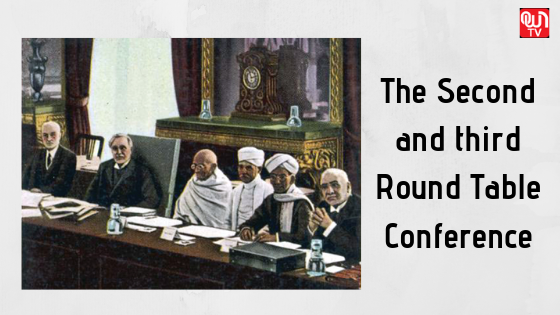Highlights from second & third Round table Conference: Constitutional Reform in British India- SSC 2019
Important Notes: Highlights from second and third round table conference
The First Round Table Conference was held between November 1930 and January 1931. No concrete decision was made in the first conference since most of the members of the Indian National Conference were imprisoned. The Second Round Table Conference started from 7th September 1931 and ended on December 1931. In this conference, Mahatma Gandhi and the other members of the Indian National Congress (INC) was present. Right before the second round table conference, Gandhi Irvin Pact was signed between Mahatma Gandhi and the Viceroy Lord Irwin.
Read more: History of Round Table Conferences: Constitutional Reform in British India

The Gandhi – Irvin Pact
After the brutal suppression of the Civil Disobedience Movement by the British, and the withdrawal of the First Round Table Conference, the Gandhi-Irwin pact was signed. According to this pact, if Gandhi agreed to attend the next round table conference, Irwin was willing to release the political prisoners except those who were violent. Gandhi agreed to this. However, the negotiations broke down and by the time Gandhi came back to India, most of the political leaders were arrested. Women and children were also attacked and brutally suppressed.

Who were the main representatives?
In this second conference, Gandhi represented the INC and Sarojni Naidu represented the Indian Women. Prominent Leaders in the Conference – Madan Mohan Malaviya, Ghanshyam Das Birla, Muhammad Iqbal, Sir Mirza Ismail Diwan of Mysore, S K Dutta and Sir Syed Ali Imam. In this conference, the position of Gandhi was a little confusion. Where the government was claiming that Gandhi is not the representative of the whole of India, Gandhi claimed that he is representing the whole of India. Following are the key takings of Second Round Table Conference –
1. India and Britain should work in collaboration with each other as equals.
2. In the first round table conference, B. R. Ambedkar proposed for separate electorates for Dalits. On this, Gandhi Ji said that Dalits are a part of Hindus, so giving separate electorates to Dalits doesn’t make sense as it will create a divide within the Hindu community.
3. Also, he said that there is no need for separate electorates for Muslims either because Muslims are a part of India or we don’t need different provisions for different individuals. He certainly was able to figure out the strategy of the British government that intends to create a divide.
Why did the second round table conference fail?
The second round Table conference turned up as a failure of Gandhi. No community was able to understand the idea of Gandhi’s stand against the distribution of seats in the legislature based on communal bias. Nothing concrete came out by the end of the Second Round table conference.
A Communal Award was introduced in the second round table conference by Ramsay MacDonald for the minority representation as there was no consensus out of second Round Table Conference.
Highlights from the Third Round Table Conference
The Third Round Table Conference started on November 17, 1932. There were only 46 delegates in the third round table as many of the leaders came to this realization now that nothing concrete will come from these conferences. The Labour Party of Britain and the INC did not attend this conference. On 17th November 1932 held in London, this time considered the report of various sub-committees appointed from time to time.
Who were the Main Representatives?
Representatives of Indian State:
Akbar Hydari (Dewan of Hyderabad), Mirza Ismail (Diwan of Mysore), V. T. Krishnamachari (Dewan of Baroda), Wajahat Hussain (Jammu and Kashmir), Sir Sukhdeo Prasad (Udaipur, Jaipur, Jodhpur), J. A. Surve (Kolhapur), Raja Oudh Narain Bisarya (Bhopal), Manubhai Mehta (Bikaner), Nawab Liaqat Hayat Khan (Patiala), Fateh Naseeb Khan (Alwar State), L. F. Rushbrook Williams (Nawanagar), Raja of Sarila (small states)
Representatives of British India:
Aga Khan III, B. R. Ambedkar (Depressed Classes), Ramakrishna Ranga Rao of Bobbili, Sir Hubert Carr (Europeans), Nanak Chand Pandit, A. H. Ghuznavi, Henry Gidney (Anglo-Indians), Hafiz Hidayat Hussain, Muhammad Iqbal, M. R. Jayakar, Cowasji Jahangir, N. M. Joshi (Labour), Narasimha Chintaman Kelkar, Arcot Ramsay Mudaliar, Begum Jahanara Shahnawaz (Women), A. P. Patro, Tej Bahadur Sapru, Dr Shafa’at Ahmad Khan, Sir Shadi Lal, Tara Singh Malhotra, Sir Nripendra Nath Sircar, Sir Purshottamdas Thakurdas, Muhammad Zafarullah Khan.
Conclusion of thirds Round Table Conference: The passage of Government of India Act
The Government of India Act, 1935 was passed by the British Parliament in August 1935 with 321 sections and 10 schedules. This act was the longest act passed by the British Parliament. Later this act was split into two parts viz. Government of India Act, 1935 and Government of Burma Act, 1935.
Main Features of the Government of India Act of 1935 was as follows:
1. Diarchy at the centre was introduced in place of Diarchy at state.
2.It abolishes the Indian Council and then leads to an advisory body on its place
3. Provision for an All India Federation with territories of British India and the princely states.
4. Elaborating safeguard instruments for minorities.
5. Extension of the franchise, division of subjects into three lists, increase in the size of legislatures, and retention of the communal electorate.
6. Separation of Burma from India
Conclusion
In the previous article, we have talked about the main reasons behind the round table conferences and discussed the First Round Table Conference in detail.
For more information click here
